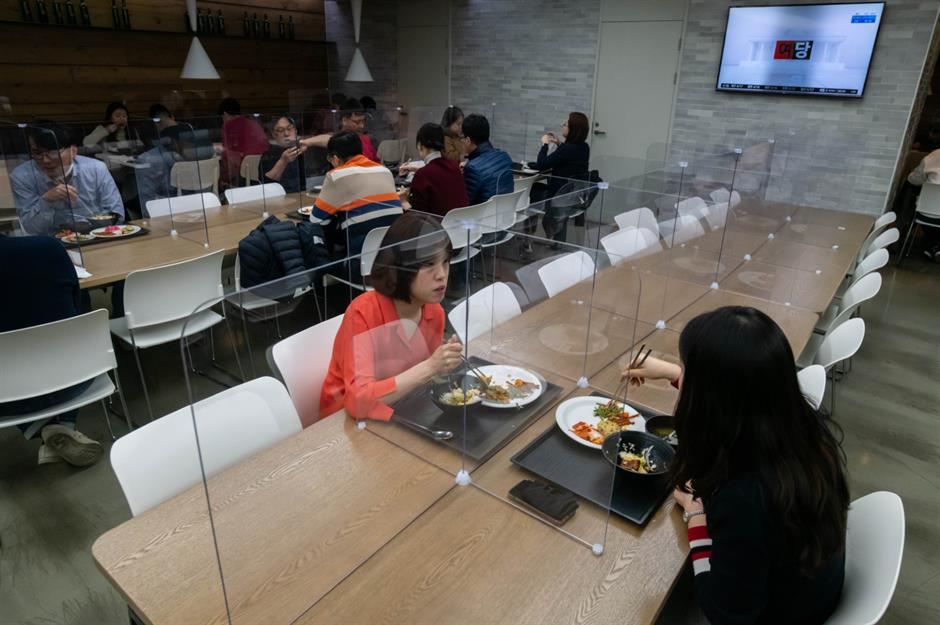How coronavirus will change the way we work forever
The future of work after COVID-19
Wondering how coronavirus might have a lasting impact on the world of work? Say hello to staggered shifts, a four-day working week and the possibility of working from home forever – or at least, those are some of the ways governments and businesses are planning to change. As Twitter has announced it will enable its employees to work at home "forever", click or scroll through to find out 25 ways COVID-19 could change working life as we have known it.
The end of the 9-5
Gone are the days of working traditional 9-5 hours – now that many people are working from home, they are able to fit their workload to their schedule, whether that’s skipping a lunch break to finish early, or starting and finishing later. According to a YouGov poll carried out in the UK, just 14% of people would opt for 9-5 hours if given the chance. Tom Cheesewright, author of Future-Proof Your Business says: “Office life and the 9-5 don’t acknowledge that we all have different body clocks, or that we’re all productive in different ways.”
More interconnected work and home life
Out-of-hours emails won’t be tolerated
A four-day working week
Working from home forever
Recently Twitter announced it will allow staff to work from home “forever”, although staff will also be able to return to offices if they want when they reopen. Other tech companies have followed Twitter's lead: Facebook has said it will aim to have 50% of its employees working remotely in the next five to 10 years, while Google is planning to extend working from home measures until the end of the year. Beyond Silicon Valley, companies including Mondelez, American insurance business Nationwide and bank Barclays have announced that they are looking to make a permanent shift to remote working.
Increased progress monitoring
As more of us work from home, it’s likely that companies will use more advanced methods to track our progress and productivity, such as tracking keystrokes on our computer or measuring the amount of time we spend away from our screens. In fact, many are already doing it – around half of large companies are using some kind of monitoring techniques to track employees, according to a 2018 survey of 239 companies by advisory company Gartner.
Now read about coronavirus: you'll never believe what's lurking on your money
More regional hubs and co-working spaces
When offices do start to reopen, companies will be keen to save on space and resources while accommodating for flexible working. This is already being seen in big businesses' decisions. Sir Martin Sorrell, former WPP CEO and head of S4 Capital, told the Financial Times that he has already started ending some leases at office sites, while insurance company Nationwide in the US has made the decision to reduce its offices down to four main corporate sites, with the rest of its workers staying at home, as part of a hybrid model. Therefore, it’s likely that many companies will pool resources into regional hubs and co-working spaces rather than traditional offices.
Fewer in-person meetings
Many of us may be hoping to never hear the word “Zoom” again after the pandemic – but chances are the video conferencing service, and other video call tools including Microsoft Teams, Skype and Google Meet are here to stay. In fact, for those workers who may no longer have access to an office space, video conferencing and instant messaging will become essential.
Now read: expert tips for better video calls for business and pleasure
Reduction in business travel
Gone are the days of jetting off across the globe for meetings and conferences. Now that companies have seen how easily these can be conducted virtually, it’s a no-brainer to reduce business travel to save money and reduce emissions. That’s not to say business travel will disappear completely, but firms are likely to take fewer trips and put more thought into the trips they do take.
Workers sitting back-to-back or side-by-side
Until a vaccine or reliable treatment is found, to prevent the transmission of coronavirus various social distancing measures will have to stay in place. And so, offices across the world will have to assess where their employees sit and the layout of rooms. This will all be factored into the design of office spaces. Workers will have to sit at a safe distance from one another – the World Health Organization recommends a 1 metre distance, while other countries follow 1.5m, 1.8m, or even 2m rules – sat either side-by-side or back-to-back. Conference rooms and meeting spaces will have to reduce their number of seats and chairs will have to be spaced out. Pictured is the office for a Brussels-based call centre, where workers are sat at socially-distanced desks.
Barriers between desks and communal seating areas
Another way in which offices may alter their design is to put physical barriers between desks to reduce the risk of infection – which could even mean that cubicles are reintroduced. In this cafeteria at the Hyundai Card company offices in Seoul, South Korea, plastic screens have been installed to allow colleagues to eat lunch safely, without spreading germs.
Plastic protection for public-facing roles
Screens have already been installed at checkouts in many supermarkets and other shops to minimise the risk of infection, and it’s likely these will remain for the foreseeable future. Self-service checkouts may also have partitions or be in cubicles, and store staff will likely have to wear masks or plastic face shields.
Frequent medical screening
In order that employees can safely return to work, many firms are considering frequent medical screening, including temperature checks and antibody tests. Companies including Walmart, Home Depot, Amazon and Starbucks are already taking employees’ temperatures, while other businesses are considering “immunity passports” to aid the return to work. Testing will be essential in some roles, such as those in beauty parlours and hairdressers, where it’s impossible to maintain any level of social distancing.
Barber shops and hair salons will be completely different
Temperature testing is not the only measure that hair salons, barber shops and beauty salons may decide to bring in to operate safely. Likely to be among the last establishments to reopen due to the near-impossiblity of maintaining social distancing in these environments, when they do get back to it workers in these occupations will need to wear masks and plastic visors, gloves, and may even don full hazmat suits, like this barber shop in Wuhan. As staff numbers will be limited in order to stick to social distancing regulations as much as possible, many salons could initially only work at 50% capacity, meaning that securing that much-needed post-lockdown haircut could be a little way off yet.
Improving work-from-home setup
When people across the world were suddenly asked to work from home if they could, many found that their environments are not conducive to focused work. In the US, 15.5% of workers have reported daily connectivity issues according to a survey by Waveform, so internet providers may look to improve Wi-Fi networks to adapt to an increasingly "remote" workforce. In the future, home-working arrangements and options may be considered when building new properties.
Greater use of e-learning
Learning is not just for students – companies are likely to use virtual learning to upskill their employees and help them to stay competitive post-pandemic. At a time when many companies can’t complete all their usual work due to the restrictions of working remotely, some are encouraging online learning to broaden workers’ skills sets.
More relaxed dress codes
With the increased number of people working from home, many have embraced more relaxed dress codes – and are desperate to keep them. Last year, one in three workers said they would pass up on $5,000 (£4.1k) of their salary to be able to dress more casually at work, in a survey by recruitment agency Randstad USA. Even when businesses do return to offices, it’s likely that dress codes could be toned down a notch in future.
Staggered work times
As countries ease their lockdowns and businesses reopen, staggered work times are likely to be introduced in order to reduce the risk of spreading coronavirus. On construction sites, workers from different trades – plumbers, builders and plasterers – are already adopting different hours to minimise contact, with sites opening earlier and closing later. Yet as staggered hours lead to quieter, less crowded public transport, it’s possible that workers will want the changes to continue post-pandemic.
We’ll use other modes of transport
In an attempt to avoid overcrowding on public transport, and to help maintain lower pollution levels, cities across the world are improving cycling and walking infrastructure. The UK is investing £2 billion ($2.5bn) into cycling and walking, including pop-up cycle paths, wider sidewalks and cycle- and bus-only streets in cities such as Manchester and London. In Italy, Milan is planning to transform 22 miles (35km) of streets into cycle paths this summer and France has invested €20 million ($22m/£18m) into a scheme to get more people cycling.
Offices will resemble hospitals
You can wave goodbye to wooden office furniture after the pandemic. Offices are likely to shift to more durable materials which can withstand frequent cleaning, as well as installing handwashing stations to allow workers to maintain good hygiene.
More automation
To minimise the amount that employees need to touch surfaces, it’s likely that offices will incorporate more automation. Think motion-activated toilet flushes, voice-activated lighting, audio and visual equipment, and smartphone-controlled elevators and coffee machines.
More rights for frontline workers
Away from offices, many frontline workers including healthcare staff, supermarket workers, cleaners and delivery workers have been risking their lives to keep working during the pandemic. Employees at firms including Amazon, Whole Foods and Instacart have held strikes over concerns for their safety during coronavirus, and it’s possible that these movements will generate support for improving rights and pay for frontline workers after the COVID-19 crisis.
More roles will be temporary or part-time
If there’s one thing we’ve learnt during the pandemic, it’s that supply and demand can change in the blink of an eyelid. While many jobs have been created in customer-facing roles, lots of them have been temporary or part-time. That could be the case for the foreseeable future, as companies hit hard by the pandemic will be reluctant to hire full-time staff and will hire workers on a more flexible basis.
Gig economy workers will need more protection
Many workers in the gig economy have been hit hard by the impact of coronavirus, as demand is drastically lower for ride-sharing services, e-scooters and vacation properties. On the flipside, it’s boosted businesses for some services such as grocery and food delivery. After the pandemic, it’s likely there will be more pressure on these companies to provide a safety net for their employees, and measures like no-contact delivery and cashless payment are likely to continue.
A surge in side hustles
As the pandemic has highlighted job insecurity, some have already taken on side hustles to improve their skills and make extra cash. In fact, a survey by GoDaddy revealed that one in five people have taken up a side hustle during lockdown in the UK – with that number jumping to one-third among those who have been furloughed or fear for the future of their jobs.
Hiring processes could be fairer
As companies continue to work remotely, employees may no longer be limited to jobs based on geographical location, which could mean companies could look to have a more diverse and inclusive workforce. Those who are carers or have disabilities may find that they are more able to commit to roles which allow working from home, while women, people of colour and minorities may be more able to access certain roles.

